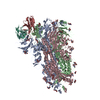+Search query
-Structure paper
| Title | Rational in silico design identifies two mutations that restore UT28K SARS-CoV-2 monoclonal antibody activity against Omicron BA.1. |
|---|---|
| Journal, issue, pages | Structure, Vol. 32, Issue 3, Page 263-272.e7, Year 2024 |
| Publish date | Mar 7, 2024 |
 Authors Authors | Tatsuhiko Ozawa / Yoshiki Ikeda / Liuan Chen / Rigel Suzuki / Atsushi Hoshino / Akira Noguchi / Shunsuke Kita / Yuki Anraku / Emiko Igarashi / Yumiko Saga / Noriko Inasaki / Shunta Taminishi / Jiei Sasaki / Yuhei Kirita / Hideo Fukuhara / Katsumi Maenaka / Takao Hashiguchi / Takasuke Fukuhara / Kenichi Hirabayashi / Hideki Tani / Hiroyuki Kishi / Hideki Niimi /  |
| PubMed Abstract | SARS-CoV-2 rapidly mutates and acquires resistance to neutralizing antibodies. We report an in-silico-designed antibody that restores the neutralizing activity of a neutralizing antibody. Our ...SARS-CoV-2 rapidly mutates and acquires resistance to neutralizing antibodies. We report an in-silico-designed antibody that restores the neutralizing activity of a neutralizing antibody. Our previously generated antibody, UT28K, exhibited broad neutralizing activity against mutant variants; however, its efficacy against Omicron BA.1 was compromised by the mutation. Using previously determined structural information, we designed a modified-UT28K (V T28R/N57D), UT28K-RD targeting the mutation site. In vitro and in vivo experiments demonstrated the efficacy of UT28K-RD in neutralizing Omicron BA.1. Although the experimentally determined structure partially differed from the predicted model, our study serves as a successful case of antibody design, wherein the predicted amino acid substitution enhanced the recognition of the previously elusive Omicron BA.1. We anticipate that numerous similar cases will be reported, showcasing the potential of this approach for improving protein-protein interactions. Our findings will contribute to the development of novel therapeutic strategies for highly mutable viruses, such as SARS-CoV-2. |
 External links External links |  Structure / Structure /  PubMed:38228146 PubMed:38228146 |
| Methods | EM (single particle) |
| Resolution | 3.22 - 3.41 Å |
| Structure data | EMDB-36905: SARS-CoV-2 BA.1 RBD with UT28-RD EMDB-36906: SARS-CoV-2 BA.1 spike with UT28-RD |
| Chemicals |  ChemComp-NAG: |
| Source |
|
 Keywords Keywords | VIRAL PROTEIN/IMMUNE SYSTEM / SARS-CoV-2 / Antibody / Spike protein / STRUCTURAL PROTEIN / VIRAL PROTEIN-IMMUNE SYSTEM complex |
 Movie
Movie Controller
Controller Structure viewers
Structure viewers About Yorodumi Papers
About Yorodumi Papers








 homo sapiens (human)
homo sapiens (human)